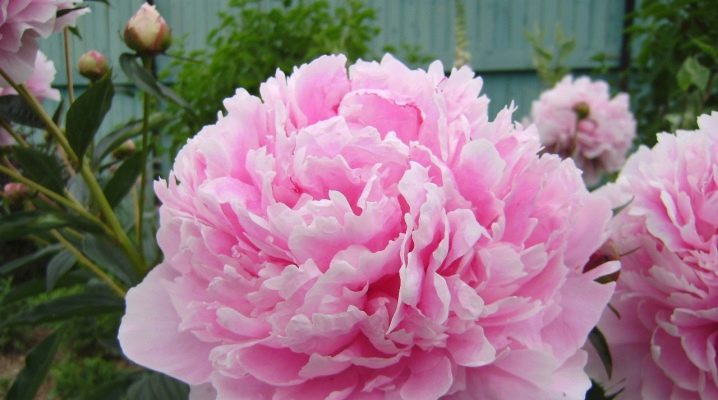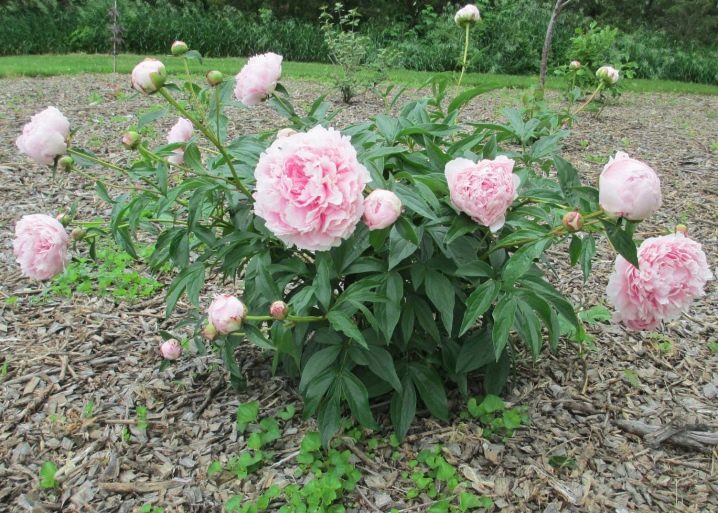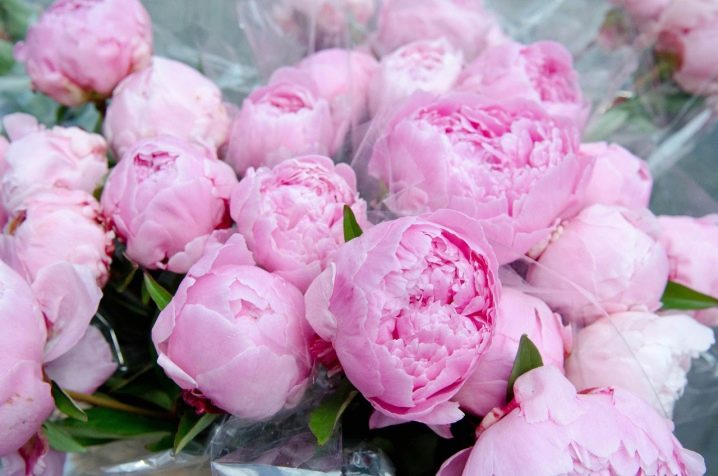Peony "Sarah Bernhardt": variety description, planting and care

Peonies are especially common among garden ornamental plants. They adorn summer cottages and courtyards of private houses. It is not surprising that these flowers are popular among amateur florists. Peonies are able to withstand any bad weather, and caring for them is not a huge task. These plants are distinguished by their luxurious contrasting colors and pleasant aroma. There are many varieties of this species in the world, of which the Sarah Bernhardt peonies stand out favorably.

Peculiarities
Peonies "Sarah Bernhardt" belong to herbaceous plants and play a decorative role. They differ from the rest in the late flowering period. This usually happens when other varieties of peonies stop flowering. If you properly care for this variety, you can significantly extend the flowering period.... In this case, it can last up to one and a half months. Peony stems are distinguished by their stability, which helps to firmly fix the buds on them.
A garter for such peonies is optional, but if you live in a region where frequent gusts of wind are a feature of the climate, then it is best to install special supports for the plant.

Brief description of the Sarah Bernhardt variety.
- The inflorescences of plants are quite large and can reach 20 centimeters in diameter.
- The petals of the representatives of this variety have a characteristic color - pale pink. The edging of the petals is painted in a silvery shade. But progress does not stand still, and breeders never cease to amaze with a huge variety of colors of these beautiful flowers. Today you can find lilac, pale white, yellow peonies.
- Openwork leaves are painted green. A characteristic difference from other varieties of peonies is that with the onset of autumn, the leaves of this variety do not turn yellow, as usually happens, but turn purple. Thanks to such an interesting color scheme, peonies attract attention even with the onset of cold weather and are the main decoration of the garden.
- Peonies "Sarah Bernhardt" are considered very light-loving plants. They develop much more slowly in the shade.
- There is a tendency towards a rather lush bloom.
- In order for the peonies to overwinter normally, it is best to use an additional protective covering that will keep the heat near the plant.



Varieties
There are a huge number of varieties of peonies in the world. Among the variety "Sarah Bernhardt" breeders have developed the following popular species.
- "Red Sarah Bernhardt"... A distinctive feature of this variety is a persistent and pleasant aroma. The palette of buds is quite rich, you can often find pale pink, purple and deep red shades of inflorescences. Refers to terry plant representatives. Adult plantings grow on average up to 80 centimeters. Peony buds can be 15 centimeters in diameter. Openwork leaves are densely located on the stem and have a dark green color. In landscape design, it is impossible to do without this variety of peonies. They are also often used as the main decorative element in floristry. Red peonies are distinguished by their ability to tolerate low temperatures normally. They are very resistant to various diseases.
- "White Sarah Bernhardt". Often this type of peonies can be found at an event such as a wedding, they are used to decorate halls and decorative compositions.The buds of the plant are painted in a delicate snow-white shade. The shape of the petals is round, their edges are silvery. The leaves are juicy green in color. In care, the flowers are unpretentious, they love soil saturated with nutrients.
- Sarah Bernard Unique. The flowers of this variety of peonies are painted in delicate shades. Often there are inflorescences of a pale pink color, which plays with tints in the sun. Violent flowering occurs at the beginning of the summer season. Florists often use such peonies in their work. Flowers will look beautiful both in a large flower bed, among many other representatives of the flora, and in a single planting. In leaving, like many representatives of this species, he is not picky.



How to plant?
Like many other plants, Sarah Bernhardt peonies require an individual approach to planting. This process will not take much of your time and effort. There are a number of mandatory rules when planting a plant.
- The process of planting peonies is best done in late summer or early fall season.
- The plant prefers soil saturated with clay and sand, the reaction of which should be slightly acidic. If loose soil is inherent in the planting site, then it is best to add organic matter to it. Humus is perfect for this purpose. Clay soil is usually mixed with river sand. Swampy areas are strongly discouraged to choose for planting. Excessive moisture levels can lead to stagnant water, which will negatively affect the root system of the peony.
- When choosing a site, one should take into account the fact that peonies are very fond of light, therefore the place should be well lit. Light shade on the site is only welcome. This will protect the leaves from the scorching sun in the middle of the day. Completely shaded areas are considered unsuitable for growing a plant, as without sunlight the plant cannot develop normally.
- For group plantings, a certain distance between plants must be observed - at least 100 centimeters. This condition is due to the branching of the plant in adulthood.
- Before planting a plant, you need to prepare the soil. Due to the rather powerful rhizome, it is recommended to make deepened holes. Drainage should be laid out in a thin layer at the very bottom, and organic fertilizer should be placed on top. The mixture can be prepared from loam, compost, and wood ash can be used in small quantities as an additional element. If the soil has an acidic environment, it is best to add a small amount of potash to it. Fertilizers for flowering plants are also applied, which you can prepare yourself or purchase at a specialized store.
- Landing. Peony bushes are placed in the hole. It is recommended to deepen the kidneys into the ground by about five centimeters. After that, the hole is covered with earth. In the next step, the plant must be watered.
- If desired, you can mulch the soil around the peony. This will help the plant survive the winter well.



How to care?
In care, peonies are a very unpretentious plant. All you have to do is do basic actions:
- weeding;
- loosening the soil;
- pruning;
- watering;
- fertilizer.
This set of rules is basic for all peonies, and if you adhere to it, the plant will grow beautiful and healthy.



Peonies "Sarah Bernhardt" require an individual approach in such procedures as feeding and watering.
Top dressing
The key to success in growing this peony variety is the right soil. In such conditions, the plants do not require feeding at all for the first few years. After 1-2 years, it is necessary to fertilize the plantings three times.
In the middle of the summer season, flower feeding can be done using bird droppings. The plant is also often fertilized with a mullein. Three liters will be enough for one peony bush.
With the onset of autumn, it is necessary to carry out the feeding process again. All that is needed is water and superphosphate. The water must be stagnant. A spoonful of mineral fertilizer will be enough for one bucket. One plant requires the same amount.


In the spring, the fertilization process consists in mulching the soil around the shrub plantations. Any mulch is suitable for this, and wood ash can be an additional component.
Watering
Peony does not need excessive moisture. Even during the period of rapid growth and development, it will be enough to water once a week. This also applies to the flowering period. After that, the flowers can be moistened even less often. But watering should be abundant. One shrub requires 3 buckets of water per watering. The evening time of the day is ideal for this process. After each watering, it is recommended to loosen the soil near the bushes.

It is important to know that wilted buds must be removed by yourself. Otherwise, they can lead to fungal diseases. Mature shrubs do not need to be covered during cold weather.
Reproduction
If you decide to breed peonies of this variety, then it is best to resort to the method, which consists in dividing the rhizomes. At the end of summer, the bushes are dug up and the roots are divided with a shovel, after which they are placed in the soil.
Some gardeners purchase seeds and use them to grow this crop. With this method, flowers tend to grow very slowly. But there are several secrets that speed up this process. It is best to harvest seeds from your own flowers when unripe. In order to avoid drying out, it is better not to hesitate with the sowing process. You can also place the seeds in a small container and cover them with damp sand, then put them in the refrigerator. The storage period should not exceed one and a half months.


In open ground, seeds are best placed in mid or late August. They must be buried no more than five centimeters into the ground. Breeding peonies using seeds is divided into two stages. From the very beginning, the seedlings need warmth, the temperature is ideal within + 18-28 degrees. At the second stage, the temperature should gradually decrease, an indicator from 5 to 10 degrees Celsius is ideal. The duration of the second stage is 2 months.


Diseases and pests
As mentioned earlier, Sarah Bernhardt peonies are very resistant to various types of diseases. But still, there are pests that pose a particular danger to the plant.
- Gray rot. This disease is one of the most common among peonies. Young plantings are most susceptible to the disease. The onset of the disease is accompanied by symptoms such as coating of leaves with plaque. For prevention, it is recommended to treat the plant with a special mixture. Three liters of the required solution is considered the norm for one shrub. You can also make special tinctures at home and spray them with peonies.
- Rust. This disease greatly affects the appearance of the plant, noticeably worsening it. Signs of infection are observed when brownish spots appear on green leaves. The appearance of this disease is influenced by the seating method: if it is too thick, then the likelihood of infection increases. Also, the appearance of rust is influenced by unfavorable weather conditions. In order for this disease to bypass your plant, you must adhere to two basic rules. Firstly, it is recommended to keep a certain distance during a group landing (at least one meter). Secondly, watering should not be carried out in wet weather.
- Mosaic. The characteristic signs of the disease are the appearance of stripes on the leaves of the plant. They usually have yellow or light green hues. It is impossible to cure this disease, therefore, with complete infection, it is recommended to remove the plant as soon as possible so as not to spoil the rest of the plantings on the site, and then burn it.



Reviews
It is impossible not to notice that on the Internet there are extremely positive reviews about the variety of peonies "Sarah Bernhardt". These flowers are favorites of both professional florists and amateurs.
They are loved for their luxurious appearance, large buds, and wonderful aroma. The colors of the traditional variety, which gardeners are very fond of, are also noted.


The most popular varieties are Red Sarah Bernhardt and White Sarah Bernhardt. People really love their rich shades.


Remarks are often expressed in the direction of the difficult reproduction of shrubs. But basically, this problem arises for novice gardeners.
Peonies are especially delighted with florists and landscape designers. In their craft, these beautiful flowers are almost impossible to do without.

Sarah Bernhardt peonies are sophisticated and elegant plants that can bring liveliness to any area. A huge advantage of plants is that they are considered perennial and adapt perfectly to any bad weather. Following all the rules, you can grow a beautiful flower that will delight you and the guests of the house with its splendor.

Flower review - in the next video







































































































The comment was sent successfully.